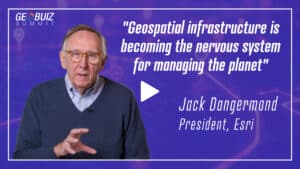Geospatial Intelligence has become indispensable to modern militaries for a host of purposes, especially in the wake of ongoing Ukraine Conflict. In this scenario, there’s an immediate need to focus on spatial needs of the armed forces, as well as involve them in policy formulations.
GEOINT comprises of imagery, imagery intelligence (IMINT) and geospatial information. The full utility of GEOINT comes from the integration of all three, resulting in more comprehensive, tailored geospatial intelligence products for meeting the wider requirements of the Armed Forces. It gives them the ability to rapidly respond to threats, providing geo-referenced visual and data products that serve as foundation and common frame of reference. These products include interactive maps, virtual flythroughs, and walk-through mission scenarios.
Geopolitical Turbulence
The Ukraine War is witnessing optimization of GEOINT, especially the use of satellites and drones, for real-time situational awareness for hi-tech engagement.
Concurrently, the Indo-Pacific has gained prominence with American moves to checkmate Chinese aggression. Indian concerns include the continuing standoff with China, Pakistan’s proxy war, the China-Pakistan nexus, and emerging threats in the Indian-Ocean with increased Chinese presence in the waters and on Coco Islands.
The importance of GEOINT or Geospatial Intelligence for our Armed Forces remains vital, as is the need for adopting emerging GEOINT technologies, developing smart and integrated security ecosystems, plus international cooperation, although the latter should only be considered a ‘bonus’.
China’s YaoGan constellation of military intelligence, surveillance and reconnaissance (ISR) satellites supports a range of geospatial intelligence capabilities: optical, synthetic aperture radar (SAR), and electronic intelligence (ELINT). China has 24×7 satellite cover astride the Tibet India border and recently deployed an AI-controlled satellite to surreptitiously monitor military areas in Bihar and a port in Japan. Beijing has also been using air balloons and hi-speed drones for collection of GEOINT.
Broader Defence Participation
India’s National Geospatial Policy 2022 aims to set up high resolution topographical survey and mapping national framework, and a high-accuracy Digital Elevation Model (DEM) by 2030 (full implementation by 2050) by promoting indigenous geospatial data industry.
The focus on commercialization is well understood considering that India’s geospatial economy is expected to grow at 12.8 percent and cross INR 63,000 crore by 2025. However, this should not be a reason to overlook the geospatial requirements of the Armed Forces.
Ironically, the 17-strong Geospatial Data Promotion Development Committee (GDPFC) has only one member from the Ministry of Defence (MoD); who can hardly ensure the considerable responsibility and role of his ministry in geospatial data acquisition – unless the ministry wants to wash its hands off from this responsibility and wants the Armed Forces to deal directly with other governmental bodies and the industry.
Moreover, the military component in the Survey of India (SoI) has been eliminated altogether; relegating defence to second place. This needs serious revision, given that the military is a major user of geospatial data.
The relevance of geospatial data will keep growing in modern wars with rapid advances in technology and advanced weapons and weapon systems, including unmanned and hypersonic platforms.
The security of geospatial data required by the Armed Forces is more complex and different than relational geospatial data; requiring data organization and structures to deny data manipulation and theft that would seriously compromise national security.
The SoI-Military Survey bond required strengthening but severing it and reducing the SoI to “peripheral” role is a setback for the Armed Forces.
Establishment of the National Spatial Data Infrastructure (NSDI) has been a good initiative but it apparently deals with only some aspects pertaining to creation of metadata of available geospatial data and does not cater inputs from the intelligence community or the Armed Forces.
Data Fusion & Interoperability
We need to work on fusion of intelligence data. Additionally, the Defence Intelligence Agency (DIA) is the central repository for all intelligence inputs pertaining to the three Services including Imagery Intelligence (IMINT) and Electronic Intelligence (ELINT). But have we integrated the aspects of topography with the DIA.
Within the existing setup, do we have adequate resources in terms of remote sensing, ELINT payloads and cartography to produce high quality fused data?
Future wars will need to be fought in a completely integrated manner by the three Services, for which, real time C4I2SR and common situational picture are essential.
The Services have been working individually to acquire Network Centric Warfare (NCW) capabilities, which now must be fully integrated, even as wars would need a national response, not by the military alone.
Fostering R&D
The global fast-paced technological advances in terms of geospatial intelligence need to be taken note of and adopted.
We need to dispense with compartmentalized thinking and switch to complete integration. For example, we are still launching satellites separately for the Army, Navy and Air Force, whereas, these could have been catering for all three with adequate redundancy in the event of a satellite captured, incapacitated or shot down by the enemy.
China has successfully allowed its remote sensing satellite ‘Qimingxing-1’ in low-Earth orbit to observe parts of India where army units are stationed and a Japanese port that often stations US naval vessels, using AI from a ground-based station for the experiment— the operation for redeployment of the satellite was autonomous without any human intervention.
Following this revelation, there has been discussion in the media about the dangers of AI-controlled satellites, drones or robots going rogue, which in military engagements could be catastrophic.
There is a view that India should not let its satellites be AI-controlled. However, acquiring a capability and employing it are two different issues.
India should develop this capability as all major powers will surely do. There has been plenty noise similarly against weaponizing of space or for that matter nukes, but research, development and deployment continues unabated.
ALSO READ: Role of GeoIntelligence in Developing National Defense Strategy









